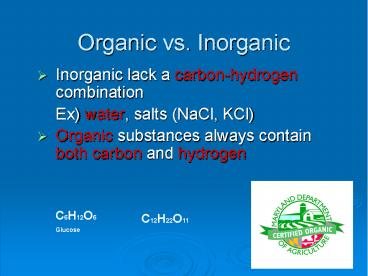Organic vs. Inorganic PowerPoint PPT Presentation
Title: Organic vs. Inorganic
1
Organic vs. Inorganic
- Inorganic lack a carbon-hydrogen combination
- Ex) water, salts (NaCl, KCl)
- Organic substances always contain both carbon and
hydrogen
C6H12O6 Glucose
C12H22O11
2
Macromolecules (Organic)
- Carbohydrates Bread, Potatoes, and Pasta
- Lipids Fats, Butter, and Oils
- Proteins Meats, Peanuts, Beans, and Eggs
- Nucleic acids DNA and RNA
3
Carbohydrates
- Elements that make up carbs C H O Always 21
ratio between H and O - Function of carbs
- Main energy source
- Structural component cell walls, insects
exoskeleton - Used by cells to recognize other cells receptors
4
Carbohydrate
5
(No Transcript)
6
- Monomer of carbohydrates
- Monosaccharides one sugar ex Glucose,
fructose, galactose chemical formula C6H12O6 - Polymers
- Disaccharides two monomers ex sucrose,
maltose - Polysaccharides many monomers ex starch,
glycogen, cellulose
7
Dehydration Synthesis Hydrolysis
8
Lipids
- Examples Fats, Waxes and Oils
- (Mostly C H) no ratio between H and O
- Function of lipids
- Stored energy
- Structural components
9
(No Transcript)
10
- Lipids are also made of
- Monomers
- 1 glycerol
- 3 fatty acids
- Two types of lipids
- Saturated contains max. H atoms.
- Unsaturated contains some CC bonds.
11
Proteins
- Elements of proteins
- C, H, O, N
- Functions
- Control rate of reactions
- Regulates cell processes (enzymes)
- Building materials (collagen elastin,
coloration pigments) - Fight disease (antibodies)
12
(No Transcript)
13
Building blocks of proteins
- amino acids (AA) are monomers or building blocks
of proteins - The protein is the Polymers
- proteins are also called polypeptides
- One bonded to another AA
- Peptide bonds are used to bond one amino acid to
another to form proteins - AA-AA-AA-AA-AA-AA
14
A large protein chain made of small amino
acids http//www.teachertube.com/view_video.php?vi
ewkeyaa818e40a6b8475f0d28
Go to Section
15
Amino Acids
Amino group
Carboxyl group
General structure
Alanine
Serine
The shape of Protein molecule is influenced by
the sequence of amino acids in it
Go to Section
16
Nucleic Acids
- Elements of nucleic acids C, H, O, N, P
- Function of nucleic acids
- Store transmit genetic info. the building
blocks to our genetic code (DNA) - Monomers of nucleic acids are called Nucleotides
- Three nucleotides of nucleic acids are
- 5-C sugar, Nitrogenous base, phosphate group
- Polymer
- DNA (deoxyribonucleic acid)
- RNA (ribonucleic acid)
17
(No Transcript)
18
The 2 Types Of Nucleic Acids
- 1. DNA (deoxyribonucleic acid)- our hereditary
info. - directs all cell activities
- 1st identified as double helix 1953 by Watson and
Crick - 2. RNA (ribonucleic acid)- transcribes hereditary
info. (copies DNA) to make a protein the body
needs - this means that proteins determine the nature
and activities of the cell
19
The Nucleotide
- All nucleotides are identical
- The only difference is the type of nitrogenous
base they have. - There are 4 types Guanine, Cytosine, Adenine and
Thymine. - These bases pair up in a specific way to make the
rungs of the DNA Double Helix.
20
Energy and Chemical Reactions
- Living things undergo thousands of chemical
reactions as part of the life process
21
(No Transcript)
22
- Certain chemical substances (catalysts) can speed
up or slow down a reaction. - Biological catalysts are called enzymes
- If it ends in ase it is an enzyme.
23
- Enzymes are an important class of catalysts in
living organisms - Mostly protein
- Thousands of different kinds
- Each specific for a different chemical reaction
24
Enzyme Action
- Enzyme-Substrate Complex
- substrates the reacting molecules the
substance(s) that the enzyme works on, - active site that portion of the enzyme into
which the reacting molecules fit - product the substance that results from the
enzymatic activity
25
Enzyme Structure
- Enzymes work on substances called substrates
- Substrates must fit into a place on an enzyme
called the active site - Enzymes are reusable!
- End in ase
-Sucrase -Lactase -Maltase
26
Active Site
- A restricted region of an enzyme molecule which
binds to the substrate.
Substrate
Active Site
27
- Lock Key- refers to how the active site
substrate fits together - there is only one key to a lock
- there is only one substrate to an active site
28
Enzyme video
- http//bcs.whfreeman.com/thelifewire/content/chp06
/0602001.html
29
Concept Map
Carbon Compounds
include
that consist of
that consist of
that consist of
that consist of
which contain
which contain
which contain
which contain
Go to Section
30
Overview of enzymes
- Enzyme- Protein that can speed up or slow down a
reaction. - Substrate-The reaction molecule, that the enzyme
works on. - Active Site- Portion of the enzyme that reacting
molecules fit in. Has a specific shape. - Lock Key fit- A specific substrate will only
fit into a specific enzyme.
31
- Factors that affect enzyme action- Temperature,
pH level, and enzyme/substrate concentration. - Enzymes become denatured with temperatures that
are too high or pH levels not 7. The active site
changes shape. - Examples of Enzymes-
- Lactase, the enzyme breaks down lactose
- Protease and peptidase - A protease is any enzyme
that can break down a long protein into smaller
chains called peptides - Amylases - breaks down starch chains into
smaller sugar molecules. - Maltase- breaks down maltose
- Catalase- breaks down Hydrogen peroxide to water.
32
Enzyme Characteristics
- Made up of proteins
- Are reusable
- Are Specific
- Required by ALL chemical processes in organisms
- Control the rate of metabolic (chemical
reactions) in the body. - Weaken chemical bonds so molecules can be made or
broken down by the body - Many end is ase

